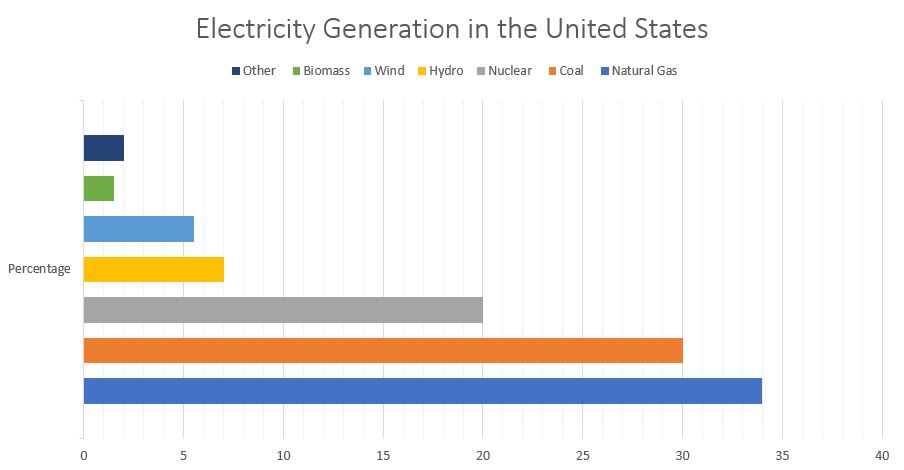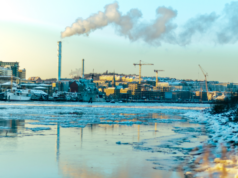Electricity is generated through a power station that is fueled by fossil fuels or a renewable source to spin the turbines which supply a current to the electromagnet that reaches the generator and creates electric power. There are many types of electric power, those of which will be discussed in this write-up.
Hydro-Electric Power
One-quarter of the sun’s energy that emits through to the earth through sunshine is used up by nature for water evaporation. As the water evaporates, it forms clouds and falls back onto the surface of the earth from the atmosphere in the form of precipitation. There are different types of precipitation, but the main is rain and snow. The kinetic energy in this evaporation and condensation process can be harvested and used to power generators that generate electricity. The power of the water cycle has been captured and used since the Middle Ages for purposes such as mills and mechanical propulsion.
The kinetic energy of water drives turbines that supply a generator with the mechanical energy needed to produce electricity. Essentially it is the altitude of water that is being taken advantage of here.
A hydroelectric power system in a river is called a run-of-river power station. They are very expensive to build because large amounts of earth debris must be displaced, and large concrete structures must be installed. Hydroelectric systems are still better than the hard-coal system despite their cost being on average 5 times greater because, in the long run, the power stations are easier to maintain and cost less to repair.
In addition to the run-of-river power station, there is another system which is called a pump storage plant. This technique utilizes a reservoir where water is collected from rivers and creeks at high altitudes and stored in a catchment around the reservoir. In many cases, the water is manually transported to the reservoir. The basic purpose of the reservoir pump storage plant is to have water available for electricity generation as needed. This could mean that during the day electricity consumption is highest in the evening after people have come home from work. As a result, the pump storage hydropower plant will be able to open the valve in front of turbine, and the turbine will begin turning whilst generating electric power. This type of a pump storage power system may also be used in airplanes where there is a need for power, quickly and at a time.
A double reservoir system is used in the areas where water is scarce. Water depleted areas have their pump storage plant placed near the mountain and one in the low-lying valley in an adjacent position. If a sudden surge of power is needed, then the water from the upper basin can flow into the bottom one. If there is a period of calm and little power is required at the time, then water is pumped into the upper basin manually to conserve for times of peak demand. One such plant that uses this pumped storage system is in Vianden, Luxembourg. Its lower reservoir sits on the Our River whereas the upper basin is positioned on Saint Nicholas Mountain. The electricity generation capacity of the plant is 1096 megawatts which translates into 1.47 million horsepower. It is not uncommon to see water being released close to 50 times during the day and also see it pumped back 50 times during inactive periods of power consumption.
There are two types of electric power; effective and reactive. Effective power is the type of power that delivers heat to a stove whereas reactive power is the requirement of magnetic fields building up and the reservoir generators are tasked with the goal of ensuring the right supply of electricity is created for and reaches the consumer.
Inherent Challenges with Pump Storage Plants
While a run-of-river power system is considered an energy producer, a pump storage plant is an energy consumer. For instance, run-of-river harvests the kinetic power of the water’s movement to generate electricity, but in a pump storage plant, power is consumed in pushing the water upstream into the top-positioned basin. Sometimes coal-fired power stations are used to push this water into the upper basin, and because it is working against gravity, it consumes considerable energy. Once the water reaches the top basin, it falls toward the lower reservoir which loses some energy in the process due to friction in the pipes.
Of the total power output generated, 15% of it is lost to facilitating the mechanical processes of the pumping plant.
One way to conserve this lost power would be to rely on windmills or wind energy systems to help drive the water into the upper reservoir. However, the inherent problem with this is that the windiest places are far from low-lying mountain valleys, but this is where the pump-storage plants must be built.
Coal
Brown coal and hard coal are the two primary types used for electricity generation. Brown coal has a low heating value and high-water content which ruins its place in the markets. Brown coal is geologically younger than hard coal. Most of the mining companies involved with brown coal use it themselves to power their stations. Regarding hard coal, there are major deposits found throughout the globe including significant sources in Australia, China, and Indonesia. The quality of coal determines its pricing and factors that play into this include combustibility through ash content, heating value, and a number of volatile components. Coal is containing low amounts of sulfur results in less pollution because less sulfur dioxide is released into the atmosphere and as a result creates a lower chance of acid rain.
Coal is really the last resort of electricity generation – at least for the household because improper use by untrained people causes greater amounts of sulfur dioxide and carbon monoxide to enter the atmosphere and increases pollution rates. However, in countries like China coal is regularly used for purposes such as household cooking but the power companies are trying to shift to using natural gas as a cleaner, more sustainable alternative.
As per how the electricity is generated, well the process entails heat creation, then water turns into steam which causes the turbine to spin, and the steam condenses back into water which regulates the cycle of power generation. As with all methods of electricity generation, turbines must spin to provide power through the shaft to the generator. As stated earlier, coal is often used in conjunction with a pump storage plant to use the force of water to turn the turbines.
Natural Gas
Natural gas it the second largest source of electric power generation in the United States. Natural gas is oligopolistic meaning that a small number of producers share the co-monopoly on the commodity. There are many ways natural gas generates electricity which include steam generation, centralized gas turbines, combined cycle units, distributed generation, gas-fired reciprocating engines, and microturbines. All of these have the use of a turbine in common as what electricity is generated through.
Centralized gas turbines work by using hot fumes from burning natural gas to turn the turbine and generate power. These are used in peak-load demand situations such as the hydroelectric pump storage plants.
Combined cycle units are the new and emerging technology that uses both a gas turbine and a steam engine where the hot fumes from burning natural gas are used to spin the turbine.
The Cost of Electricity
The average price of electricity per kilowatt hour is 19 cents. However, the cost to generate that electricity including expenses of sales, grids, high-tension power lines, and metering is around 11 cents per kWh. As a result, the price is essentially double the cost of generation. This is largely due to state-imposed taxes and levies. In rural areas, the cost of electricity will generally be higher than in densely populated zones. In many cases, amortization is also considered with electricity pricing because in the next 40 years close to 80% of the power stations will need to be replaced.
Electricity in Developing Countries
Electricity in developing countries bears a similar yet distinct image. For example, in Indonesia, there are also power stations and voltage levels for transmitting and distributing power, but the key difference is that demand far outweighs supply. In fact, limits are imposed on how much power can be used by a consumer through sealed cut-offs. Sealed cut-offs do exist in industrialized countries, but they are done so within the electrical wiring to prevent overloads on a house that can lead to a fire. There are also shutdown schedules in developing countries, so everyone is aware of the times power will not be available.
Renewable Electricity Sources
Biomass
Biomass which is essentially planted life consumes only 1 percent of the sunlight to conduct its growth process of photosynthesis. As an average, there are about 12 tons of biomass that grows per hectare of arable land each year. Biomass contributes to human life in the form of its presence in the food chain and the use of wood and plant material to create products such as clothing fibers and wood-derived pulp/paper. There are many indirect ways biomass can generate electric power. For example:
- Fuel gas production through direct combustion if dry matter such as domestic wastes, straw, and wood.
- Anaerobic fermentation that creates biogas from wet waste like dung.
- The Fischer-Tropsch fermentation method that leads to diesel production from plants with sugars, starches, and cellulose.
- Extraction of oil plants that create plant oils.
There are neutral environmental effects of using biomass as an energy source because it is not free from air pollution. Biomass creates methane, carbon dioxide, nitrogen, hydrogen sulfide, and trace amounts of carbon monoxide. End-to-pipe technologies which are systems used to control the pollution after it has been created can be used in conjunction with biomass to minimize or eliminate the contaminating substrates. Biomass is also easy to store so incorporating it into the current energy supply chain is relatively straightforward. Energy plantations can be set up on fallow agricultural land that uses fast-growing grasses such as elephant grass. This grass can be harvested and used in a biomass-fired power plant to create electricity. Often, elephant grass is referred to as energy grass because of its increasingly greater use in biomass farming activities. The downside is that it would create a monoculture and large amounts of artificial fertilizer would be required to maintain the integrity of the soil.
Wind
The kinetic energy of the wind is an operation of the wind to the cubic power. This basically means that if the speed of the wind doubles then the energy derived from the wind will increase by 2^3 which equals 8 times. Most of the wind farms in the USA are concentrated in the central south. Duration time is a measurement that is used to calculate the amount of electric power which can be generated in a year. The calculation is based on the total energy output during the year divided by the maximum wind energy output. The measurement is classed by the hour, and a general range predicts between 1600-2200 hours of duration time per year. Wind is only able to produce the total demand for electricity output on its own about 5 percent of the time. It must be supplemented with another source to spin the turbines and power the generators to ensure that adequate supply meets demand. As a result, it does have the advantage of saving fossil fuels. By general estimates, a windmill that has a duration time of 1600 hours and operates a 2 MW producing 2000 KW will generate a little over 3 million kilowatts of electricity per year. This is enough to power close to 1000 households. However, the reliability of the energy source has been debated because it does not meet peak demand periods – if the wind isn’t blowing, then there is no electricity. It used to be there was no storage system to conserve and preserve the harvested power for later use. However, compressed air, rail energy, flywheels, ultracapacitors, and solid-state batteries do help in mitigating and conserving the harvested energy for use in the future.
One option that has not seen enough development is the use of excess power to create hydrogen via electrolysis. A hydrogen fuel cell could then be used to convert it back to electric power where it can power vehicles for transportation.
One inherent challenge with wind energy systems is the high-tension grids sometimes cannot stand up to the fast and powerful transmission of power. As a result, wind power has still yet to prove its economical benefits compared to fossil fuel-based sources of electric power. Wind energy systems require adequate grids to transmit the electricity, and while they can produce significant amounts of electric power, they must be supplemented with conventional storage plants to meet peak demand periods.
Nuclear
It is estimated there are about 450 nuclear power stations in operation around the world. Light water reactors are the most common type of nuclear power station in Western countries. However, some countries oppose the use of nuclear power such as Austria and Italy. One of the primary benefits that drive countries to explore and use nuclear power is the fact that it does not create carbon dioxide emissions. Nuclear fusion is also a phenomenon that has taken precedence over nuclear fission because no after-heat or long-half life radioactive isotypes are left remaining. The stage of development for nuclear fusion was still in the same phases when nuclear fission was discovered, and the first uranium isotype was split. Fusion will still take decades before it can contribute to the energy supply chain.
Conclusion
In conclusion, electricity is a useful resource that is essential to human living. While there are fossil-fuel based ways to generate this electricity to power our lives, renewable sources of energy are working to replace the limited potential of commodities such as coal and natural gas. There are also inherent problems with the hydroelectric power system that uses a pump storage plant system to deliver water to the top reservoir which was discussed in the preceding paragraphs. However, hydroelectricity is a renewable energy source and is likely to stick around for the foreseeable future. It may not be viable to those areas that have water scarcity problems but with the right improvements in technology can be made to work. Furthermore, natural gas and coal are still in abundant quantities, but the rate of their use and the pollution they emit do not make them sustainable for the long-term. Essentially, a power source is required to spin the turbines to transmit power to the generator in order to create electricity, but the question of which resource is best suited for power generation is the one many environmentalists and professionals employed in the energy sector contemplate on. Other emerging technologies that will permit biomass, nuclear, and wind to take greater control of the electricity market is clearly in the works.







